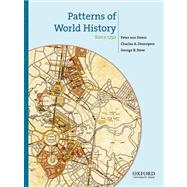Patterns of World History Since 1750

Patterns of World History Since 1750
- ISBN 13:
9780195333343
- ISBN 10:
0195333349
- Format: Paperback
- Copyright: 12/09/2011
- Publisher: Oxford University Press
Rent
Sorry, this item is currently unavailable.
Note: Supplemental materials are not guaranteed with Rental or Used book purchases.
Extend or Purchase Your Rental at Any Time
Need to keep your rental past your due date? At any time before your due date you can extend or purchase your rental through your account.
Summary
Patterns of World History comes to the teaching of world history from the perspective of innovations the engine of historical change. Innovation is nothing new; so what we advocate in this book is a distinct intellectual framework for understanding innovation through its patterns of origin, interaction, and adaptation. Each small or large technical or cultural innovation originated in one geographical center, or independently in several different centers. As people in the centers interacted with their neighbors, the neighbors adapted to - and in many cases were transformed by - the innovations. By adaptation we include the entire spectrum of human responses, ranging from outright rejection to creative borrowing and, at times, forced acceptance. What do we gain by studying world history as patterns of innovation? First, if we consider innovation to be a driving force of history, it helps satisfy an intrinsic human curiosity about origins-our own and others. Perhaps more importantly, seeing patterns of innovation in historical development brings to light connections and linkages among peoples, cultures, and regions that might not otherwise present themselves. At the same time such patterns can also reveal differences among cultures that other approaches to world history tend to neglect. For example, the differences between the civilizations of the Eastern and Western Hemispheres are generally highlighted in world history texts, but the broad commonalities of human groups creating agriculturally-based cities and states in widely separated areas also show deep parallels in their patterns of origins, interactions and adaptations: such comparisons are at the center of our approach. Second, this kind of analysis offers insights into how an individual innovation was subsequently developed and diffused across space and time-that is, the patterns by which the new eventually becomes a necessity in our daily lives. Through all of this we gain a deeper appreciation of the unfolding of global history from its origins in small communities to the densely populated large countries in our present world. Finally, our use of a broad-based understanding of innovation allows us to restore culture in all its individual and institutionalized aspects-spiritual, artistic, intellectual, scientific-to its rightful place alongside technology, environment, politics, and socio-economic conditions. That is, understanding innovation in this way allows this text to help illuminate the full range of human ingenuity over time and space in a comprehensive, evenhanded, and open-ended fashion.






